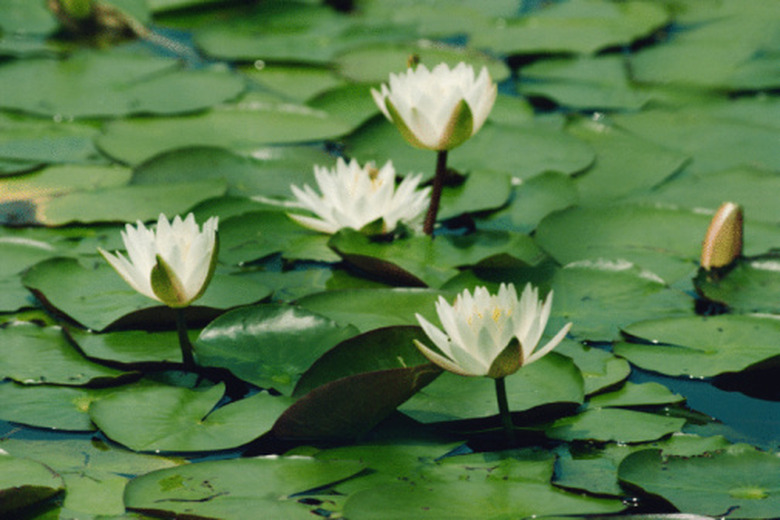What Eats Water Lilies?
Water lilies are flowering, aquatic plants that come in a variety of bloom colors. Water lilies depend on visiting insects to pollinate flowers. However, some insect pests attack water lilies. Several animals also like eating these plants.
Types
The black aphid and aquatic leaf beetle both feed on water lilies, according to Colorado State University Extension. Animals such as beavers, ducks and deer also eat parts of the water lily. Fish, such as grass carp, sometimes eat water lilies as well.
- Water lilies are flowering, aquatic plants that come in a variety of bloom colors.
- Water lilies depend on visiting insects to pollinate flowers.
Importance
Aphids suck sap from plant tissue, leaving water lilies yellow or brown with distorted shapes. Aquatic leaf beetles chew holes in the leaves, causing stippling. Larger animals eat water lily leaves, seeds or roots. Heavy feeding that removes most of the leaf may damage water lilies, especially over the course of two to three years.
Considerations
In a pond garden, keep aphids at bay by spraying lilies with a strong stream of water. Remove aquatic leaf beetle larvae by hand. In both cases, remove severely infested plants to avoid spreading. Put up fencing or plant additional preferred plants as a deterrent to other animals. Contact your local county extension agency or department of natural resources regarding trapping, removing or killing larger water garden pests, such as the muskrat.
- Aphids suck sap from plant tissue, leaving water lilies yellow or brown with distorted shapes.
Care Of Hardy Water Lilies
Replenish the water in your pond or growing container regularly so the water remains 12 to 48 inches deep. Measure from the top of the soil to the surface to ensure that the depth is at least 12 inches deep. The amount of fertilizer you use will vary depending on your pond or pot's size, the plant's size and the temperature. Kit and Ben Knotts, founders of Water Gardeners International, use one Pondtabbs per gallon of soil. Clip off spent leaves and blossoms from the lilies to keep your pond or container clean. Repot the new plant in clay soil so the soil doesn't cloud the water when you replace it. Place a plastic pond cover over the pond or insert a birdbath heater into the water if winters are very cold in your area.
- Replenish the water in your pond or growing container regularly so the water remains 12 to 48 inches deep.
References
- Washington Department of Ecology: Fragrant Water Lily (Nymphaea Odorata)
- Colorado State University Extension; Water Garden Plants: Problems and Solutions; Judy Sedbrook
- U.S. Forest Service; "Got Duckweed? Get Carp!"; Kathleen Snodgrass; March 2008
- Minnesota Department of Natural Resources: Muskrat
- Missouri Botanical Garden: Nymphaea "James Brydon"
- Missouri Botanical Garden: Nymphaea "Comanche"
- Missouri Botanical Garden: Nymphaea "Sunny Pink"
- The New Sunset Western Garden Book; Kathleen Norris Brenzel, Editor
- Victoria: Fertilizing Waterlilies and Aquatic Plants
- Fine Gardening: Make a Big Splash with a Tiny Water Garden
- Purdue University Extension: Management of Ponds, Wetlands, and Other Water Reservoirs to Minimize Mosquitoes
